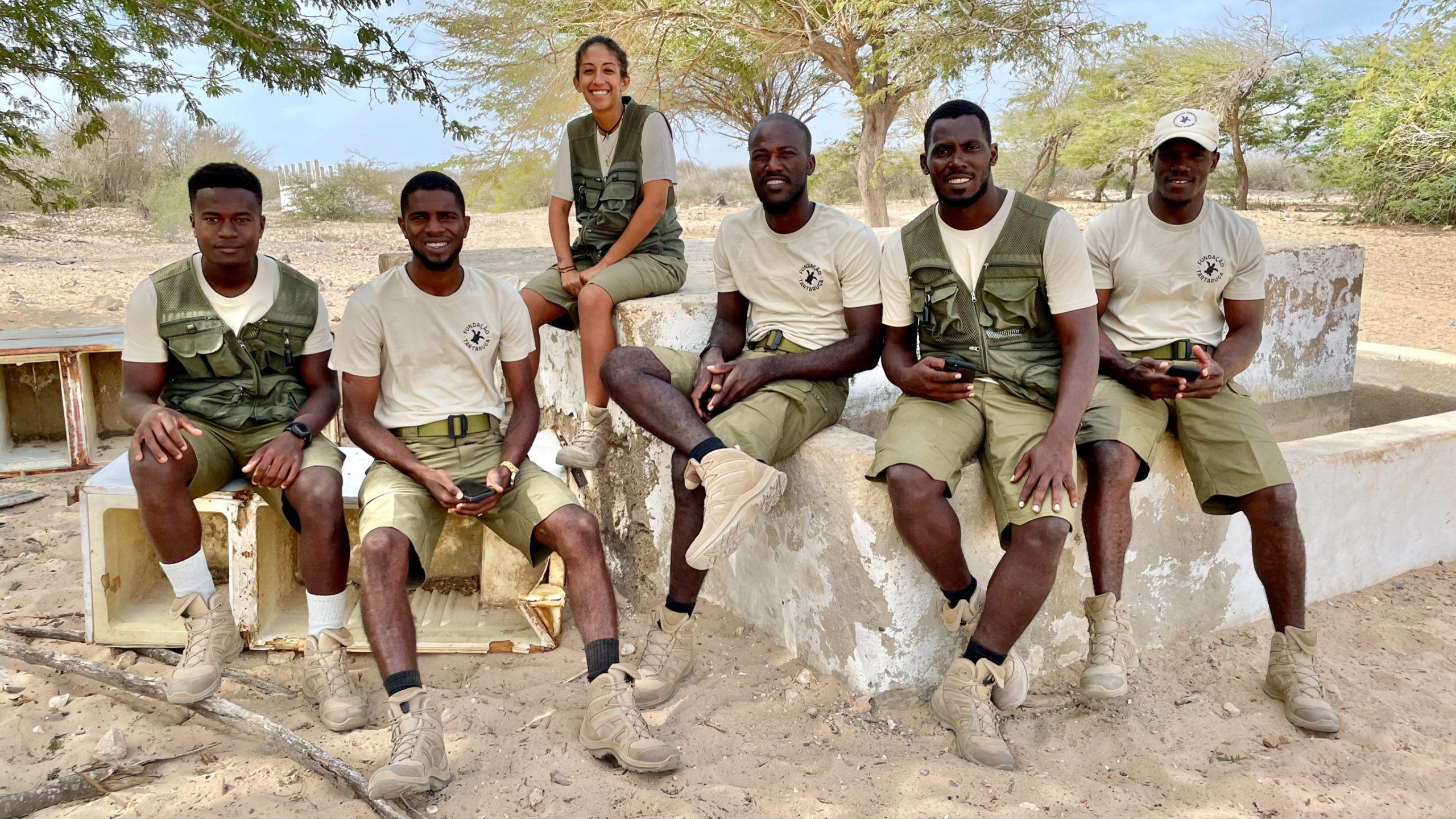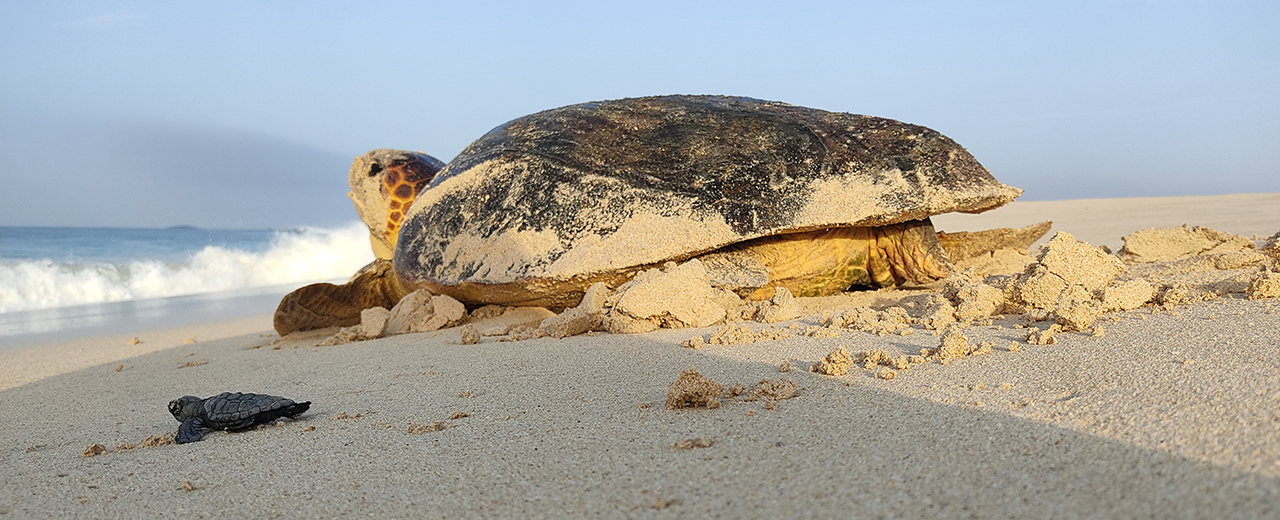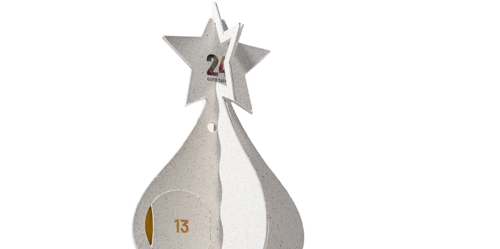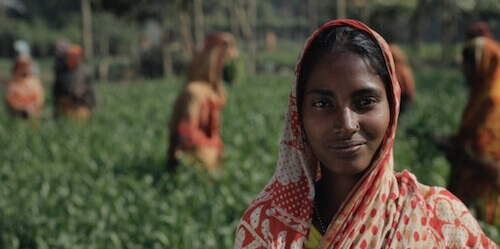 A safe start for loggerhead sea turtles
A safe start for loggerhead sea turtles
Protecting nesting sea turtles on Boa Vista from poachers
Sea turtles spend their entire lives at sea. Only the females come on land from time to time to lay their eggs. Under the cover of night, they dig a nest on the beach, lay their eggs inside and leave the incubation to the sun. The sex of the hatchlings depends on the temperature in the nest: when it is warmer, more females develop, when it is cooler, more males. After about two months, the young hatch and find their way to the sea on their own. In the water, sea turtles are elegant and enduring swimmers; on land, however, they move clumsily with great effort. The loggerhead sea turtle (Caretta caretta) nests on the beaches of the island nation of Cape Verde in West Africa. During the nesting season, the females come ashore up to five times to lay between 60 and 120 eggs each time. For the first time after about 20-30 years, the female turtles return to their native beach to nest again.
Necessity
Protection of loggerhead sea turtles from poaching and protection of nests on Boa Vista, Cape Verde
Activity
18 local rangers guard 20 km of nesting beach and relocate endangered nests
Countable effort
Number of sea turtles and eggs protected from raids by poachers and that can develop into hatchlings
Result
By protecting about 2,400 mother animals in the first year, more eggs can be laid from which young animals hatch. This allows the population to grow again
Systemic effect
The sea turtle population on Boa Vista has recovered and stabilised; due to the presence of the rangers, poaching declines
Background
Sea turtles have inhabited the world’s oceans for over 110 million years. They survived the dinosaurs and ice ages. Then came humans. Although they are now protected in most countries, sea turtles are threatened with extinction (Spotila, 2004). Excessive poaching, bycatch in fisheries, pollution of beaches and waters with plastic waste, mass tourism as well as climate change threaten the existence of sea turtles. Cape Verde is home to the world’s third largest nesting population of loggerhead turtles, with about two-thirds of the animals nesting on the island of Boa Vista alone (Reischig, 2018). The population of loggerhead turtles in the Northeast Atlantic is classified as “vulnerable” by the International Union for Conservation of Nature (IUCN, 2015) and is one of the most threatened marine turtle populations in the world (Wallace et al. 2011). In 2008, the Turtle Foundation began its work and established its first conservation camp on Boa Vista after a report of 1,200 dead turtles the year before (representing about 30% of the annual nesting population) drew attention to the acute plight of sea turtles (Reischig, 2018). Despite major conservation efforts, there were still 54 cases of poaching on Boa Vista last year. In order to end poaching for good, former poachers are being trained as rangers and employed in conservation. To ensure the sustainability of the conservation project, the Turtle Foundation works closely with the local authorities and the local people. Through education, the children learn about the importance of and threats to sea turtles. The creation of alternative income opportunities is also one of the missions: A women’s group that was previously involved in preparing and selling turtle meat now makes soap and chutneys.
The good deed
Your good deed will make it possible to set up two protection camps on the beaches in the north of Boa Vista. Local rangers live in the camps during the nesting season from June to October to protect about 2,400 females and about 12,000 nests on 20 km of nesting beach from poachers. From the camps, the rangers patrol the beaches during the critical evening, night and morning hours. In addition, data on nest activity is collected and endangered nests (for example due to light pollution from beach hotels) are relocated to a hatchery, a fenced-off section of the beach. Through your good deed, three major beach clean-ups can also be carried out, as fishing nets and plastic rubbish that washes ashore are often death traps for mothers as well as hatchlings. The ultimate goal here is to prevent poaching in order to help the endangered population of loggerhead turtles to recover in the long term.

About Cape Verde Islands
Praia
Capital
561,901
Number of inhabitants
3,445.8
Gross domestic product per capita per year
Rang 128 von 191
Human Development Index
There are many volcanoes in the West African island nation, with Pico do Fogo being the highest at over 2,829 metres. It last erupted in 2014.
About the organization and further information
Association
Turtle Foundation
Website
https://www.turtle-foundation.org/

Further information and source
- Reischig, T., E. Resende, and H. Cordes. 2018. Drones for turtles: controlling poaching of nesting loggerhead sea turtles with night vision unmanned aerial vehicles on Boavista Island, Cabo Verde. African Sea Turtle Newsletter 10: 9—13
- Spotila, J., 2004. Sea Turtles – A complete guide to their biology, behavior, and conservation, The John Hopkins University Press, Baltimore
- Casale, P. & Marco, A. 2015. Caretta caretta (North East Atlantic subpopulation). The IUCN Red List of Threatened Species 2015: e.T83776383A83776554.
- Wallace BP, DiMatteo AD, Bolten AB, Chaloupka MY, Hutchinson BJ, Abreu-Grobois FA, et al. (2011) Global Conservation Priorities for Marine Turtles. PLoS ONE 6(9): e24510.
- The IUCN Species Survival Commission, 1995. A Global Strategy for the Conservation of Marine Turtles.




